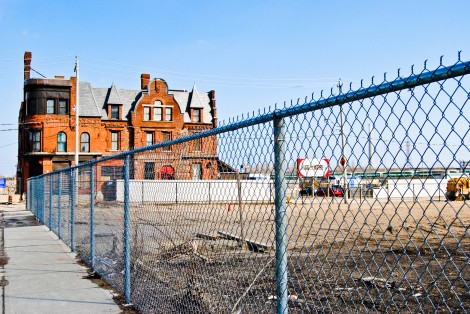W
hen much of the zoning around King East switched from industrial to commercial a few years ago, it kicked off the developments and revitalization the area is famous for today. Growing up there was like a Trudeauian wet dream. Elementary school classes were populated by a whole assortment of skin tones and socio-economic statuses, just like the diversity-themed mosaic at the school’s entrance doors.
I grew up on King East. The residential alcove where I lived — steps away from the downtown core — incited a good deal of jealousy in peers whose curfews wouldn’t allow for their commutes and so had to stomach their parents’ Paul Simon albums on the drive back home to suburbia.
But the neighbourhood hasn’t always been the site of fashionable condos, urbane furniture stores, and organic pet boutiques. The Distillery District was an abandoned eyesore you glimpsed beyond the waste filtration plant on your way toward Cherry Beach. There were distinct drop-offs into shady territory, which were just a few TTC stops from a pre-gentrified Regent Park, the disrepair on Sherbourne south of Bloor, or the hostels of Moss Park — where two new condos have just broken ground. This is the area Michael Moore epitomized as a representative Canadian ghetto in Bowling for Columbine. Unbeknownst to Mr. Moore, this area was also the blueprint for a successful integration of community and private housing.
Today, the cultural nucleus that was once exclusive to King West is crawling eastward. The Distillery District is now touted as a historic site and developers are jumping on opportunities to expand the district. The once decrepit plot is now a cosmopolitan oasis, with its array of galleries, studios, and live theatre attracting culture-seekers. It’s home to Toronto’s first commercial brewery and a few independent bakeries, cafes, and restaurants producing fare that could make any bologna-eating schmuck feel like a gourmand.
Some, however, are less optimistic about this district, which seems to have materialized overnight. There’s something about Toronto’s new and beloved hotspot that leaves an artificial aftertaste in their mouths. After all, the site was created not out of altruistic responsibility for arts and culture but for the sake of commerce and condo-building.
The Distillery and the few trendy niches cropping up around it do seem to come out of nowhere. It’s a kind of Potemkin village catering to yuppies and tourists on rented Segways. A block north, a new Porsche dealership has opened up, though one wonders if the clientele would be comfortable parking outside it. A block south, tags spray-painted on a basketball court are hidden under a fresh coat of paint.
We have to ask how much this really does for the community that actually lives here. Does it just whitewash the heterogeneity and everything else the neighbourhood was once known for? The landmark Canary Restaurant at Front and Cherry was forced to close its doors when the plot was sold to developers.
Some are resisting the change. On the corner of King and Sherbourne someone has spray-painted “fuck gentrification” on the stoop of a real estate firm. With the revitalization of Regent Park we saw the displacement of many low-income families whose previous homes were given to those willing to pay market rent. The Real Jerk restaurant will be packing up soon, joining other less-known mom-and-pop shops who’ve faced extinction by gentrification.
The way of life for most here hasn’t been threatened in the same ways yet. My own has only been improved by the recent changes, and let’s face it, I’ll continue to sip on overpriced coffee while it lasts.






